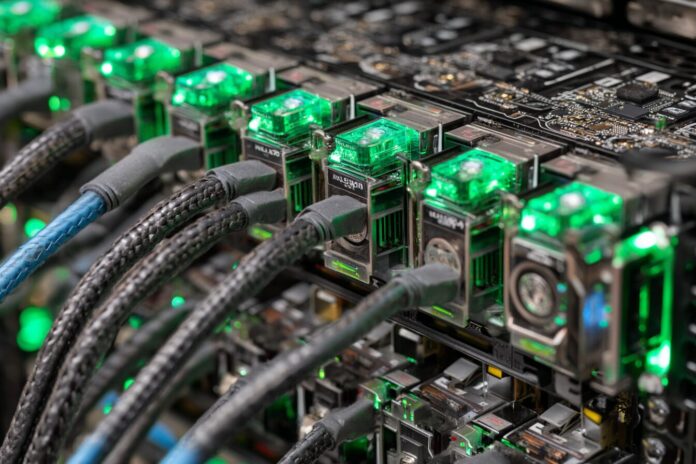Redefining High-Performance Computing for a Greener Future
The acceleration of artificial intelligence (AI) and high-performance computing (HPC) is transforming industries, but it also brings increased environmental challenges. Most importantly, organizations require more computational power while grappling with the environmental cost of data centers. Therefore, sustainable solutions in high-performance computing are crucial to meet modern demands without compromising the environment.
The NVIDIA HGX B200 emerges as a groundbreaking platform that marries top-tier performance with eco-conscious design. By harnessing innovative materials and energy-efficient components, this system not only raises the bar in computational capability but also pioneers a significant reduction in carbon emissions. Besides that, it provides the computing infrastructure needed for accelerating AI research and data analytics without the hefty environmental toll.
Unleashing Performance: Inside the NVIDIA HGX B200
The HGX B200 platform is engineered with precision, integrating eight NVIDIA Blackwell B200 GPUs. With each GPU empowered by 180 GB of HBM3E high-bandwidth memory, the system ensures vast compute throughput and memory bandwidth. Because of this robust architecture, businesses can process complex workloads at incredible speeds while enjoying enhanced energy efficiency.
Due to its superior design, the B200 platform features remarkable capabilities including FP4 Tensor Core Performance, up to 1.4 TB of fast memory, and memory bandwidth of 62 TB/s. Moreover, the GPU-to-GPU NVLink Bandwidth reaches 1.8 TB/s per GPU, enabling seamless data exchange between processors. Furthermore, the configurable thermal design power of up to 1,000W allows tailored performance based on workload demands. As detailed by Together AI, these features combine to deliver up to 2.3x faster throughput at FP16 precision compared to previous models.
A Quantum Leap in Sustainability
One of the most impressive aspects of the HGX B200 is its commitment to sustainability. By introducing a design that reduces embodied carbon emissions, the system sets a new industry benchmark in environmental responsibility. For example, NVIDIA’s developer blog highlights that the B200 achieves a 24% reduction in carbon intensity compared to the older HGX H100 series.
This leap in sustainability is achieved through optimized materials, energy-efficient manufacturing, and higher compute performance per watt. Because every component is designed with efficiency in mind, the embodied carbon intensity drops significantly—from 0.66 gCO2e to 0.50 gCO2e at FP16 precision. Most importantly, this efficiency makes a compelling case for responsible AI deployment, aligning technical advancements with industrial sustainability goals.
Unmatched Energy Efficiency: Stretching Every Kilowatt
The HGX B200 is not just about raw power but also about delivering energy efficiency that is unmatched in the industry. With up to 15x more energy efficiency on AI inference workloads, the B200 transforms how enterprises approach power consumption. This milestone allows companies to accelerate their AI initiatives while reining in energy usage.
Because energy constitutes a significant portion of operational costs, reducing power consumption by up to 93% for similar inference tasks is a breakthrough. Such impressive figures are a direct result of innovations in GPU architecture and cutting-edge networking technologies like NVIDIA’s Quantum-X800 InfiniBand and Spectrum-X Ethernet. Ultimately, this design strategy assists companies in minimizing their environmental footprint while still achieving robust, scalable performance.
Smarter Material Choices, Lower Emissions
The sustainability message of the HGX B200 extends well beyond energy efficiency. NVIDIA has placed strong emphasis on the materials used within each B200 baseboard. Most importantly, the recourse to smarter materials and design practices results in significantly lower carbon emissions during production and throughout the lifecycle of the product.
Innovative choices in thermal components, integrated circuits, and memory modules account for much of this improvement. As outlined in the Product Carbon Footprint Summary, these advancements reflect a deliberate strategy to cut down on material use and promote energy-efficient operational performance. Therefore, the HGX B200 not only advances computational capabilities but also champions sustainability from the ground up.
Empowering the Next Era of Responsible AI
Because efficiency and environmental stewardship go hand in hand, the HGX B200 is setting the stage for a new era in AI and HPC. This groundbreaking system allows researchers and enterprises to achieve outstanding performance without having to compromise on sustainability. In many respects, it symbolizes a vital turning point in the industry, where technological ambition and environmental responsibility meet.
Furthermore, this integration of high performance with reduced emissions means industries no longer need to choose between advancing their computational goals and adhering to carbon reduction mandates. As referenced by AI Journ, the HGX B200 paves the way for an era where rapid AI advancements and green computing are not mutually exclusive but rather symbiotic in fostering a sustainable future for technology.
The Road Ahead: Green Innovation Beyond Compute
Looking forward, NVIDIA’s commitment to transparency and sustainability establishes a benchmark for the future of data center technology. Therefore, by publishing third-party verified carbon footprint data, NVIDIA is driving accountability within the industry. This approach inspires other tech companies to follow suit, thereby creating a broad movement towards greener innovation across multiple sectors.
Moreover, this proactive stance on environmental challenges is vital as regulatory bodies and global enterprises increasingly demand robust carbon reduction strategies. As highlighted by Uvation, innovations like the HGX B200 are crucial to future-proofing data centers and ensuring that progress in AI and HPC does not come at the expense of our planet. As a result, the future of high-performance computing is not only faster and more efficient—it is also greener and more environmentally responsible.
References
- NVIDIA HGX B200 Clusters – Together AI
- NVIDIA HGX B200 Reduces Embodied Carbon Emissions Intensity – NVIDIA Developer Blog
- Product Carbon Footprint (PCF) Summary for NVIDIA HGX B200 – NVIDIA
- The NVIDIA B200: Redefining AI Compute for a Sustainable Future – AI Journ
- H200 Computing: Powering the Next Frontier in Scientific Research – Uvation



